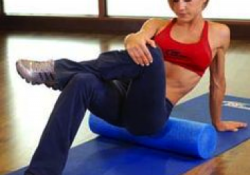
Myofascial Release
Trainer – “ Okay, so before you start your workout today… go ROLLOUT!”
“Rollout?? What in the world does that even mean?”
This technique is rising in the therapy and exercise world and is becoming more widely accepted. Most professionals recommend rolling the muscles before and/or after exercise.
“If I am going to contort around this roller, how does it work?”
First we have to look at the muscle and see how it becomes tense and needs to be released. The muscle is made up of multiple layers of muscle and connective tissue. The myofascial areas should be elastic and movable, but when the muscles are tensed, they are tight and “knotted”. So the purpose is to use gentle pressure to find these knots. These areas can be painful and prevent the muscles and joints from moving in the correct range of motion. The knot that is detected is a trigger point in the muscle where muscle fibers have contracted and can restrict optimal blood flow.
“So if I am going to do this properly, what muscles should I do it on?
Some examples of the muscles that are popular in self myofascial release are the gastrocnemius and soleus muscles of the calves, the IT band on the outside of the upper thigh, the adductors of the inner thigh, the piriformis deep in the posterior hip, and the latissimus dorsi of the shoulder girdle. Also, the quadriceps, hamstrings, and thoracic spine can benefit from this technique. For exercise, using this method on these sore muscles releases the tension and allows for sore muscles to gain motion again. It also activates what is called golgi tendon organ reflex that is just a fancy way to say it relaxes the muscle.
“If I’m not exercising, can this still benefit me?”
Absolutely! There is a man who is currently bound to a wheel chair because of muscular tears in his back. He is working on building up his muscular strength, range of motion, all while working out as much as he can. From being stuck in a wheel chair all day, his hip flexor muscles are contracted constantly. So you can imagine what happens when he lays flat. These muscles spasm out and hurt like crazy! It is because they are so tense and then stretch out! This is when we bring out the myofascial release and foam roller to help relax those muscles. He will lay flat and roll out his muscles until they relax. The more and more he has done this, the less his muscles tend to tighten up and hurt. He has become immensely more mobile and able to transfer from his chair to his bed with far less pain and tightness to worry about. If he can use it and see results, so can anyone else.
“Alright, then how exactly am I to do this once I get a roller?”
Find that sore muscle that you just worked out yesterday that makes you cringe to touch. Place the roller towards the end that is furthest from the center of your body. Then slowly start applying pressure to the muscle and move the roller over your muscle until you find a trigger point. Once you find that knot, hold pressure there for about 30 seconds or until you feel the muscle begin to release. Whatever muscle you decide to do, roll the muscle towards your heart. As you are rolling the muscle, you want to be sending the blood flow to your heart instead of away.
“Will this help with my flexibility? This is stretching right?”
That’s been quite a controversial topic in research. There have been some results that show that it does help with the first 48 hours of muscle soreness and pain from the “direct onset muscle soreness” that occurs with exercise. Foam rolling can help with short-term flexibility within the first 10 minutes after the release. Then if foam rolling is continued regularly for more than 2 weeks then there will be evidence of some increased flexibility.
“Will this help my knee pain?”
It can, depending on the source of the pain. A lot of people complaining of knee pain after exercise or any type of strenuous activity can just be experiencing tight muscles. The muscles in the upper thigh connect down to the knee. When the muscles are too tight, they pull on the tendons of the knee and can cause pain. The IT band will pull on the outer parts of the knee while the adductor muscles pull on the inner part of the knee. The quads will tighten on the front part of the knee and lower into the shin, which can cause pain even after the muscles are no longer sore from exercise. Once the muscles are rolled out, released, and relaxed, the pain in the knees that is relieved. ** Not all knee pain is caused by sore muscles**
“So I feel like this will all around help my muscles and exercise performance?”
Yes and yes. When you walk into the gym, go straight to the foam roller and activate those muscles, release those knots, and relax those joints in order to get prepared for your workout. Once you are done working out, GO ROLL THOSE MUSCLES AGAIN! You have just fatigued those muscles and broken them down, they deserved to be massaged and relaxed (PS it helps prevent some soreness for the next 48 hours) Hey, you want to take Saturday off… roll those muscles at home to keep up the range of motion of your joints and to not stiffen up.
“Wow so it sounds like you really believe in the effectiveness of myofascial release?”
Yes I do! And no matter what the controversies say down the road, I will always roll my muscles out to keep my muscles elastic and healthy.

